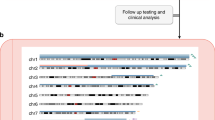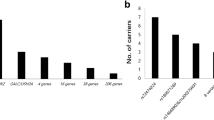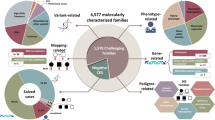Abstract
Long continuous stretches of homozygosity (LCSH) are associated with risk of recessive disorders. Though LCSH can be detected by SNP microarrays, additional testing is necessary to clarify the clinical significance. This study is to assess the yield of additional exome sequencing (ES) after LCSH detection and inform the likelihood of eventual diagnosis. In 2226 patients referred to SNP microarrays, 35 patients met the criteria of indicative LCSH. These patients were recruited and went through additional ES. The diagnostic yield was analyzed, and the LCSH pattern was compared between eventually diagnosed cases and those undiagnosed. The results showed additional ES attained a diagnostic yield of 31.4% (11/35), but only one-third of the yield (11.4%, 4/35) was relevant to LCSH. In contrast, two-thirds of the diagnostic variants (20%, 7/35) were de novo or dominantly inherited, irrelevant to the original LCSH finding. No particular LCSH pattern, including the chromosomal coverage or LCSH size, was found to associate with the diagnostic outcome. We concluded that additional ES after LCSH detection could reveal diagnostic variants, but it is strongly recommended to consider all possible inheritance mode, as the diagnostic variants may be irrelevant to the original LCSH finding.
This is a preview of subscription content, access via your institution
Access options
Subscribe to this journal
Receive 12 print issues and online access
$259.00 per year
only $21.58 per issue
Buy this article
- Purchase on Springer Link
- Instant access to full article PDF
Prices may be subject to local taxes which are calculated during checkout


Similar content being viewed by others
References
Kearney HM, Kearney JB, Conlin LK. Diagnostic implications of excessive homozygosity detected by SNP-based microarrays: consanguinity, uniparental disomy, and recessive single-gene mutations. Clin Lab Med. 2011;31:595–613.
Miller DT, Adam MP, Aradhya S, Biesecker LG, Brothman AR, Carter NP, et al. Consensus statement: chromosomal microarray is a first-tier clinical diagnostic test for individuals with developmental disabilities or congenital anomalies. Am J Hum Genet. 2010;86:749–64.
Mason-Suares H, Kim W, Grimmett L, Williams ES, Horner VL, Kunig D, et al. Density matters: comparison of array platforms for detection of copy-number variation and copy-neutral abnormalities. Genet Med. 2013;15:706–12.
Bruno DL, White SM, Ganesamoorthy D, Burgess T, Butler K, Corrie S, et al. Pathogenic aberrations revealed exclusively by single nucleotide polymorphism (SNP) genotyping data in 5000 samples tested by molecular karyotyping. J Med Genet. 2011;48:831–9.
Wang JC, Ross L, Mahon LW, Owen R, Hemmat M, Wang BT, et al. Regions of homozygosity identified by oligonucleotide SNP arrays: evaluating the incidence and clinical utility. Eur J Hum Genet. 2015;23:663–71.
Wiszniewska J, Bi W, Shaw C, Stankiewicz P, Kang SH, Pursley AN, et al. Combined array CGH plus SNP genome analyses in a single assay for optimized clinical testing. Eur J Hum Genet. 2014;22:79–87.
Sund KL, Zimmerman SL, Thomas C, Mitchell AL, Prada CE, Grote L, et al. Regions of homozygosity identified by SNP microarray analysis aid in the diagnosis of autosomal recessive disease and incidentally detect parental blood relationships. Genet Med. 2013;15:70–8.
Pajusalu S, Zilina O, Yakoreva M, Tammur P, Kuuse K, Molter-Vaar T, et al. The diagnostic utility of single long contiguous stretches of homozygosity in patients without parental consanguinity. Mol Syndromol. 2015;6:135–40.
Prasad A, Sdano MA, Vanzo RJ, Mowery-Rushton PA, Serrano MA, Hensel CH, et al. Clinical utility of exome sequencing in individuals with large homozygous regions detected by chromosomal microarray analysis. BMC Med Genet. 2018;19:46.
Kearney HM, Thorland EC, Brown KK, Quintero-Rivera F, South ST, Working Group of the American College of Medical Genetics Laboratory Quality Assurance Committee. American College of Medical Genetics standards and guidelines for interpretation and reporting of postnatal constitutional copy number variants. Genet Med. 2011;13:680–5.
Richards S, Aziz N, Bale S, Bick D, Das S, Gastier-Foster J, et al. Standards and guidelines for the interpretation of sequence variants: a joint consensus recommendation of the American College of Medical Genetics and Genomics and the Association for Molecular Pathology. Genet Med. 2015;17:405–24.
Fromer M, Moran JL, Chambert K, Banks E, Bergen SE, Ruderfer DM, et al. Discovery and statistical genotyping of copy-number variation from whole-exome sequencing depth. Am J Hum Genet. 2012;91:597–607.
Li LH, Ho SF, Chen CH, Wei CY, Wong WC, Li LY, et al. Long contiguous stretches of homozygosity in the human genome. Hum Mutat. 2006;27:1115–21.
Makrythanasis P, Nelis M, Santoni FA, Guipponi M, Vannier A, Bena F, et al. Diagnostic exome sequencing to elucidate the genetic basis of likely recessive disorders in consanguineous families. Hum Mutat. 2014;35:1203–10.
Eaton A, Hartley T, Kernohan KD, Ito Y, Lamont RE, Parboosingh JS, et al. When to think outside the autozygome: best practices for exome sequencing in “consanguineous” families. Clin Genet. 2020;6:835–43.
Wright CF, FitzPatrick DR, Firth HV. Paediatric genomics: diagnosing rare disease in children. Nat Rev Genet. 2018;19:253–68.
Wakeling MN, Laver TW, Wright CF, De Franco E, Stals KL, Patch AM, et al. Homozygosity mapping provides supporting evidence of pathogenicity in recessive Mendelian disease. Genet Med. 2019;21:982–6.
Del Gaudio D, Shinawi M, Astbury C, Tayeh MK, Deak KL, Raca G, et al. Diagnostic testing for uniparental disomy: a points to consider statement from the American College of Medical Genetics and Genomics (ACMG). Genet Med. 2020;7:1133–41.
Srivastava S, Love-Nichols JA, Dies KA, Ledbetter DH, Martin CL, Chung WK, et al. Meta-analysis and multidisciplinary consensus statement: exome sequencing is a first-tier clinical diagnostic test for individuals with neurodevelopmental disorders. Genet Med. 2019;21:2413–21.
Magi A, Tattini L, Palombo F, Benelli M, Gialluisi A, Giusti B, et al. H3M2: detection of runs of homozygosity from whole-exome sequencing data. Bioinformatics.2014;30:2852–9.
Acknowledgements
We would like to acknowledge the affected individuals and their families for the participation in the study. This work was supported by the National Key R&D Program of China (No. 2019YFC1005100 and No. 2018YFC1002204, to YY); the National Natural Science Foundation of China (No. 81873735 and No. 81500972 to YF; No. 81670812 and No. 81873671, to YY); Shanghai Rising-Star Program (20QA1408200, to YF); the Jiaotong University Cross Biomedical Engineering (No. YG2017MS72, to YY); the Shanghai Municipal Commission of Health and Family Planning (No. 201740192, to YY); the Shanghai Shen Kang Hospital Development Center new frontier technology joint project (No. SHDC12017109, to YY); the Shanghai Science and Technology Commission (No. 19140904500, to YY); Shanghai Municipal Education Commission-Gaofeng Clinical Medicine Grant Support (No. 20191908, to YY); Precision Medical Research of National Key Research and Development Program (2016YFC0905100, to WQ and XG).
Author information
Authors and Affiliations
Corresponding authors
Ethics declarations
Conflict of interest
The authors declare that they have no conflict of interest.
Additional information
Publisher’s note Springer Nature remains neutral with regard to jurisdictional claims in published maps and institutional affiliations.
Supplementary information
Rights and permissions
About this article
Cite this article
Fan, Y., Wang, L., Sun, Y. et al. Diagnostic yield of additional exome sequencing after the detection of long continuous stretches of homozygosity (LCSH) in SNP arrays. J Hum Genet 66, 409–417 (2021). https://doi.org/10.1038/s10038-020-00854-1
Received:
Revised:
Accepted:
Published:
Issue Date:
DOI: https://doi.org/10.1038/s10038-020-00854-1



